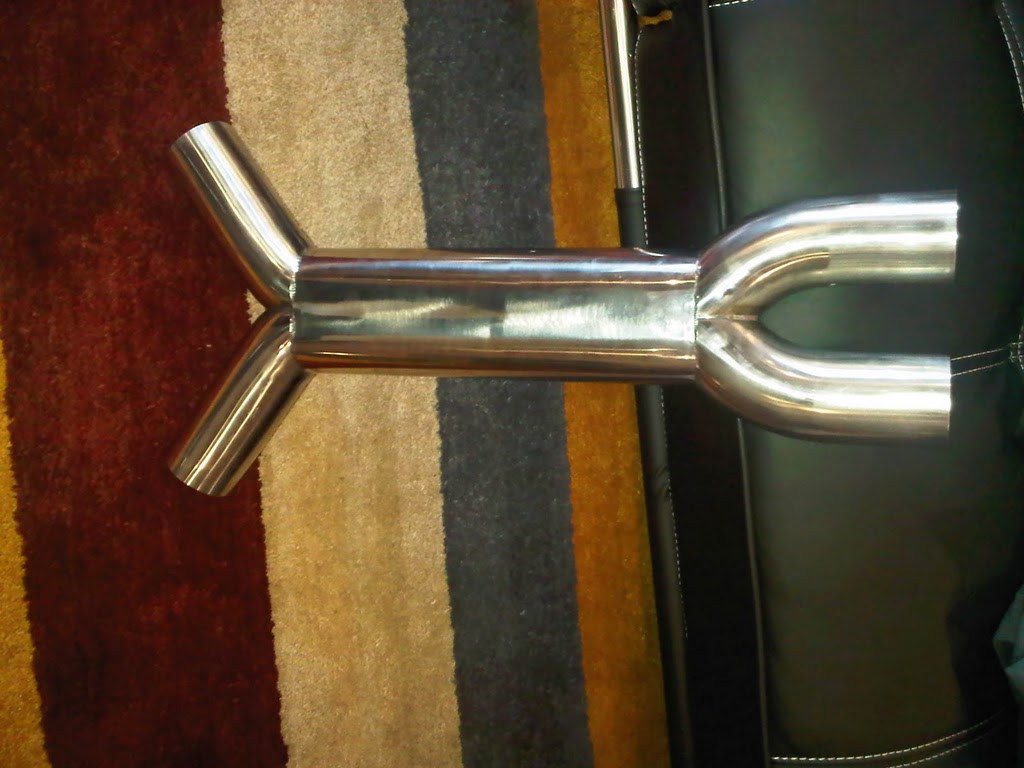impact of unequal length tailpipes
#31
The hot rodders used put spray paint on the downpipes and then go for a hard drive. Where the paint burnt off was where they installed the crossover. You will probably find that's is about where the "cross over" is in the original front muffler. When I welded up the Y section for my single 3" system I just measured this distance and that's were it is.
Yesterday I installed the Hooker aerochamber muffler directly after the Y section where the original front was. Now this is a straight through muffler you can just about poke your arm through. Dropped the noise significantly, especially at 2000 rpm where it spends most of its time. tight fit, had to bend the shield slightly to get it in.
Pleasant note. About as loud as a stock exhaust but is all straight through
Yesterday I installed the Hooker aerochamber muffler directly after the Y section where the original front was. Now this is a straight through muffler you can just about poke your arm through. Dropped the noise significantly, especially at 2000 rpm where it spends most of its time. tight fit, had to bend the shield slightly to get it in.
Pleasant note. About as loud as a stock exhaust but is all straight through
#32
Nordschleife Master
Thread Starter
I don't know what length of (dead end) pipe that works out to, or where it would fit under our cars. It may be possible (from what I've read in acoustics) that you could do a combination of a shorter length of pipe with a large-ish end chamber at the dead end, to give the same effect - volume of the end chamber would have to be equivalent to that of the length of dead-end pipe you were not able to extend out. Kind of like a large Helmholtz resonator, but used to cancel a sound. I have not heard of anyone doing the latter, however.
Yes, one would want to hear what are the problem frequencies first and then add the resonator to cancel specifically those.
When I looked into it, I concluded that drone comes from the lub-a-dub of our uneven firing order finding it's way through the system and rearing it's ugly head at some component's natural frequency. That lub-a-dub occurs every 720 degrees for our 90 degree crank plane V8, and works out to about 40 Hz (about the lowest sound we can hear) at about the usual RPM's folks complain about drone (1700-2600 RPM). (Though I don't remember if I recalculated everything after learning how temperature affects the speed of sound!).
In systems that have a good cross-over, people still complain about drone. This leads me to believe that drone is caused by the pipe lengths and the exhaust system resonating certain frequencies. I will add boundaries to the system in a way that the pipe sections are short and dissimilar length.
I am using 1400-1500 ft/s in my calculations.
Other things to consider are mount points (are you dampening an antinode?), consistency of material sizes, thickness of material, mandrel bends (or not), quality of products used, lengths of pipes. I believe all these can affect the tone by bringing in timbre effects and bringing out (or dampening) natural frequencies.
I disagree that adding similar design resonators in series will ever start to increase noise level, but I don't know that from experience. However, I have also considered having different resonator designs (that is, from different manufacturers) in series, as a possible way of achieving a "richer" exhaust tone.
Yes, fat stainless pipes look money.
The hot rodders used put spray paint on the downpipes and then go for a hard drive. Where the paint burnt off was where they installed the crossover. You will probably find that's is about where the "cross over" is in the original front muffler. When I welded up the Y section for my single 3" system I just measured this distance and that's were it is.
Yesterday I installed the Hooker aerochamber muffler directly after the Y section where the original front was. Now this is a straight through muffler you can just about poke your arm through. Dropped the noise significantly, especially at 2000 rpm where it spends most of its time. tight fit, had to bend the shield slightly to get it in. Pleasant note. About as loud as a stock exhaust but is all straight through
Do you have the CFM numbers for that muffler? Not all straight thru mufflers flow the same. Perforated cores flow more than louvered cores. Constant mean flow mufflers flow more than mufflers in which the flow slows down. Straight path mufflers flow more than mufflers with a curved flow path.
#33
Do you have the CFM numbers for that muffler? Not all straight thru mufflers flow the same. Perforated cores flow more than louvered cores. Constant mean flow mufflers flow more than mufflers in which the flow slows down. Straight path mufflers flow more than mufflers with a curved flow path.
#34
Rennlist Member
Hi Tuomo,
Yep, I had also come across that excellent doc. I believe I calculated just shy of 6 feet of pipe for what I wanted!
For my goals, I have not yet decided what to do in that area under the TT: using a large diameter mid pipe as you plan to do, thus helping smooth out the uneven firing sound, or, instead, keeping the pipes separate so I can use an absorption muffler in each separate pipe with a potenially larger difference between the through-pipe and the casing. I need to calculate what I can fit there in each scenario, then decide which may be better for my goals.
There seem so many potential contributing factors, that this could certainly be the case. I agree that having the various boundaries and differences in sizes is a good approach to addressing the problem. It is re-assuring to see more thoughts along these lines.
Good to know - thank you. I keep seeing different numbers to use, depending on exhaust gas temperature assumed, and have not been sure which numbers to use, but I also have not taken temp readings myself to try to come up with some numbers to use. From what I understand, the exhaust gas temperature also varies, depending on what RPM is sustained and for what length of time.
Agree. Though, depending on the relative locations of the attachment points, on the exhaust system (undesired node or antinode?) as well as on the vehicle (large flat surface would amplify an undesired sound if using a more solid mount), a harder or softer mounting may be desired.
My hope is that the better quality mufflers don't have any of this self-generated noise, but I may be being a bit too optimistic on this....
I appreciate you bringing up this topic!
In systems that have a good cross-over, people still complain about drone. This leads me to believe that drone is caused by the pipe lengths and the exhaust system resonating certain frequencies. I will add boundaries to the system in a way that the pipe sections are short and dissimilar length.
Good to know - thank you. I keep seeing different numbers to use, depending on exhaust gas temperature assumed, and have not been sure which numbers to use, but I also have not taken temp readings myself to try to come up with some numbers to use. From what I understand, the exhaust gas temperature also varies, depending on what RPM is sustained and for what length of time.
The problem with adding multiple very similar silencers in series is that all mufflers have some inefficiencies. By inefficiencies I mean that to some extent all of them convert the kinetic energy of the mean exhaust flow to sound and heat. Think of blowing over a bottle. These happen at the same frequencies for similar mufflers. What one wants is dissimilar mufflers so that one muffler silences the self-generated noise of the other muffler. (I ahve no experience, but this is what I've read.)
I appreciate you bringing up this topic!
Last edited by hernanca; 05-30-2011 at 11:40 PM. Reason: fixed formatting; service->surface!
#35
Nordschleife Master
Thread Starter
Got some cheap but pretty good looking ss mufflers. Straight thru, 2 x oval 3" with a curve and 1 x round 4" with straight pipe.
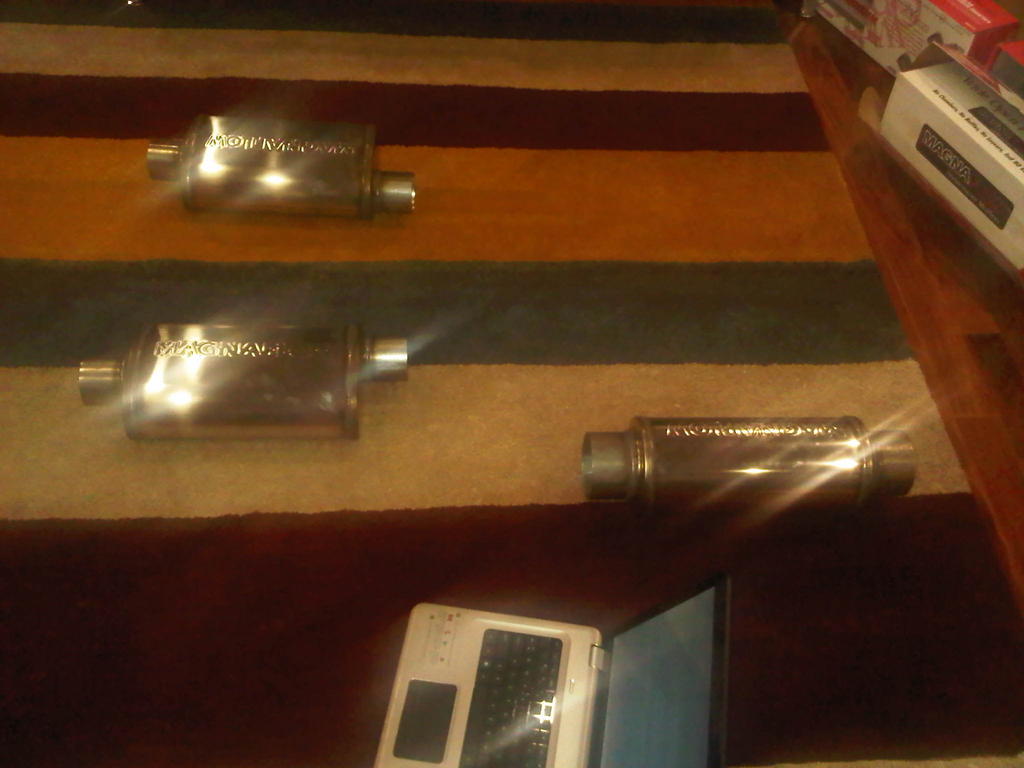
Also, figured out that the maybe the HQ resonator may in fact help the sound after all.
Assuming that the pulses are completely even after the cross-over, 8 equally spaced bangs per 2 revolutions, and assuming that SOS in hot exhaust gas is 1400 ft/s, 1.5 ft difference in pipe lengths would cancel the pulses at 7000 rpm. This would not work.
However, suppose that the pulses aren't completely combined. We know they aren't, because otherwise a single-pipe, dual-plane crank motor would sound the same as single-pipe, single-plane crank motor.
If the firing order is 1 3 7 2 6 5 4 8 per two revolutions, there are two big bangs and six small bangs per revolution. The first big bang is when the cylinders 1 and 3 fire consecutively into the passenger side exhaust manifold and the second is when cylinders 6 and 5 fire consecutively on the driver side. The big bangs are equally spaced relatively to each other, so the frequency of the big bangs is equal to the engine rpm. This amounts to maximum attenuation from 1.5 ft asymmetric length at 7000/4 = 1750 rpm. Exactly where I want to get rid of the drone! [EDIT: I am writing these posts often pretty tired. That should be 7000 * 4, not 7000 / 4, I think. Which would say the unequal length is not going to shift the wave the right amount.]
This brings me to another point. All the RMBs I am seeing basically have two separate pipes. Someone MUST immediately design and build the following RMB: The two separate pipes combined into a larger single oval pipe. If my computations are correct and as long as the engine has an appropriate cross-over upstream, this RMB should give an even note and less unpleasant noise around 1500-2000 rpm.
EDIT. Sure enough, search found a bunch:
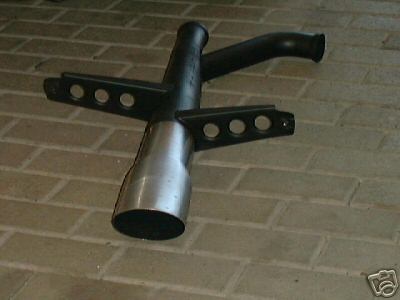
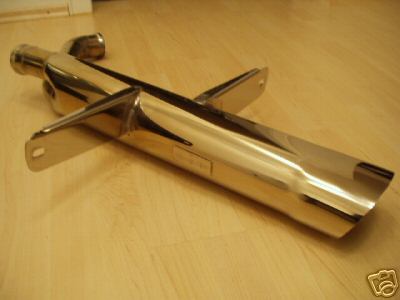

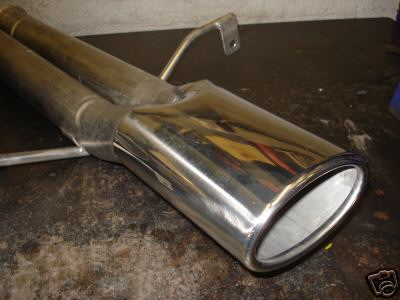

Also, figured out that the maybe the HQ resonator may in fact help the sound after all.
Assuming that the pulses are completely even after the cross-over, 8 equally spaced bangs per 2 revolutions, and assuming that SOS in hot exhaust gas is 1400 ft/s, 1.5 ft difference in pipe lengths would cancel the pulses at 7000 rpm. This would not work.
However, suppose that the pulses aren't completely combined. We know they aren't, because otherwise a single-pipe, dual-plane crank motor would sound the same as single-pipe, single-plane crank motor.
If the firing order is 1 3 7 2 6 5 4 8 per two revolutions, there are two big bangs and six small bangs per revolution. The first big bang is when the cylinders 1 and 3 fire consecutively into the passenger side exhaust manifold and the second is when cylinders 6 and 5 fire consecutively on the driver side. The big bangs are equally spaced relatively to each other, so the frequency of the big bangs is equal to the engine rpm. This amounts to maximum attenuation from 1.5 ft asymmetric length at 7000/4 = 1750 rpm. Exactly where I want to get rid of the drone! [EDIT: I am writing these posts often pretty tired. That should be 7000 * 4, not 7000 / 4, I think. Which would say the unequal length is not going to shift the wave the right amount.]
This brings me to another point. All the RMBs I am seeing basically have two separate pipes. Someone MUST immediately design and build the following RMB: The two separate pipes combined into a larger single oval pipe. If my computations are correct and as long as the engine has an appropriate cross-over upstream, this RMB should give an even note and less unpleasant noise around 1500-2000 rpm.
EDIT. Sure enough, search found a bunch:




Last edited by ptuomov; 11-10-2010 at 07:34 AM.
#36
Captain Obvious
Super User
Super User
The "bangs" are equali spaced (time) but not equal in length (distance). Does this make a difference to you? There are a $hitload of assumptions in this theory of yours. I hope they are mostly correct.
#37
Nordschleife Master
Thread Starter
Even if all the HQ computations are incorrect and HQ assumptions untrue, this new design is still almost certainly going to be an improvement to the current completely separate dual pipes. There are so many proven changes going in.
#38
Three Wheelin'
This brings me to another point. All the RMBs I am seeing basically have two separate pipes. Someone MUST immediately design and build the following RMB: The two separate pipes combined into a larger single oval pipe. If my computations are correct and as long as the engine has an appropriate cross-over upstream, this RMB should give an even note and less unpleasant noise around 1500-2000 rpm.
I may be completely off though.
#39
Nordschleife Master
Thread Starter
Search tells me you are not off. Anyone have sound file for both dual and big single RMB?
#40
Nordschleife Master
Thread Starter
Ok, I pulled the trigger and ordered a custom mid pipe from Spintech.
parallel 2x3" to 4" oval Y-pipe
+ 4" oval pipe section
+ PBR40VL 4" oval muffler
+ 4" oval to 106 degree 2x3" Y-pipe
= a lot of wasted money if I screwed anything up
The "muffler" is this: http://www.spintechmufflers.com/muff.../prod_820.html. The "muffler" is in quotation marks for obvious reasons, with the Y-pipes it's just a low-pass filter and mixing bowl for the pulses.
parallel 2x3" to 4" oval Y-pipe
+ 4" oval pipe section
+ PBR40VL 4" oval muffler
+ 4" oval to 106 degree 2x3" Y-pipe
= a lot of wasted money if I screwed anything up
The "muffler" is this: http://www.spintechmufflers.com/muff.../prod_820.html. The "muffler" is in quotation marks for obvious reasons, with the Y-pipes it's just a low-pass filter and mixing bowl for the pulses.
#41
Three Wheelin'
Very nice. Did you look into the Dr.Gas stuff also by chance? I think they and spintech go hand in hand. They have the oval tubing, transitions, etc.
http://www.drgas.com/oval_tubing.htm
Spintechs from what I remember were pretty heavy, robust mufflers. It should last a good while.
http://www.drgas.com/oval_tubing.htm
Spintechs from what I remember were pretty heavy, robust mufflers. It should last a good while.
#42
Nordschleife Master
Thread Starter
Very nice. Did you look into the Dr.Gas stuff also by chance? I think they and spintech go hand in hand. They have the oval tubing, transitions, etc. http://www.drgas.com/oval_tubing.htm Spintechs from what I remember were pretty heavy, robust mufflers. It should last a good while.
The Dr. Gas stuff -- looks like they are very much in cahoots (sp?) with Spintech. So, good stuff.
I got a negative response from all the other firms that I contacted. By negative I mean that they told me lies -- sweet little lies -- about how sound waves work and how gas flows. The physics worked differently depending on what product they could offer or could not offer. Oh well...
In any case, Spintech was the first of the suppliers that said they can do it. They also said that it would probably work but that, regardless, it would be expensive.
That's the spirit of America, right there. "Yes can do, but it's gonna cost you." Gives me hope, specifically and in general.
Last edited by ptuomov; 11-19-2010 at 09:19 AM.
#43
Nordschleife Master
Thread Starter
Here's the first mid pipe iteration. The oval pipe is actually a muffler. I'll get another one with just an oval pipe and no muffler as well. Then, it's time for some sound and back pressure experiments.
